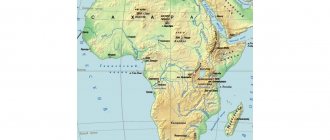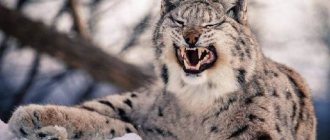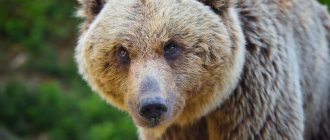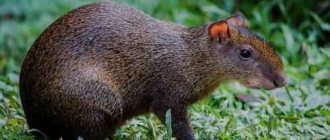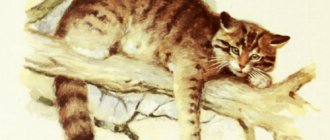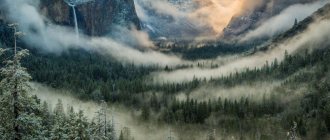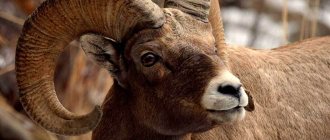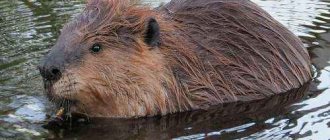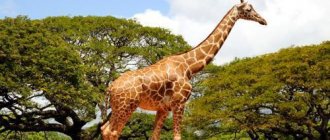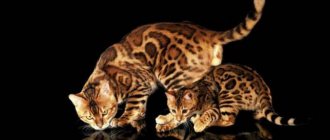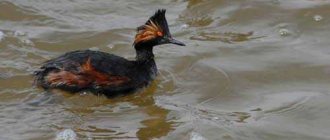The territory of the Caucasus amazes with the diversity of its fauna. The forests are home to a wide variety of animals. This is due to the geographical location of the region, which has ideal conditions for the development of a wide variety of animals, from tropical to northern representatives. The western and middle territory of Ciscaucasia is inhabited by animals of the steppe fauna that came from the southern Russian Plain. Animals from Central Asia have found refuge in the Terek-Kuma regions. Among the representatives of the fauna there are such valuable animals as otters, martens, foxes and many other interesting species.
Hoofed inhabitants of the Caucasus
Chamois
An interesting representative of the artiodactyls of the Caucasus is the chamois. A unique species that prefers to live high in the mountains. It reaches speeds of up to 50 km/h and is capable of jumping over rocks. Chamois have beautiful, dense fur.
Caucasian tour
Another species is the aurochs, which also lives on the steep slopes of the Caucasus mountains. Males have huge horns on their heads, reaching a length of a meter.
Bezoar goat
Also in the mountains of the Central Caucasus lives the bezoar goat - a rare and very beautiful representative of the fauna, which can be found at an altitude of 4000 m. These graceful animals, well protected from the cold by dense fur, live on the slopes and deftly move along them.
Insects
Karakurt . This creature belongs to the genus of arachnids, which are given the name “black widow”. They are black in color and the females eat the males after mating. A special feature is red spots on the abdomen. The size of the female is up to 2-3 cm. The male is up to 1 cm. If the female’s red spots on her stomach disappear, she is especially dangerous! (KK)
Blueberry Ciscaucasia . Lepidoptera butterfly, very beautiful. Included in category 1 QC. Wing length up to 16 mm, span – 30 mm. (KK)
Zegris Euphema , a white butterfly with a wingspan of up to 4 cm. The color of the wings is white, on the upper wings there are orange-yellow spots and black specks (CK).
Zernithia Polyxena . Swallowtail butterfly, wingspan up to 5.6 cm. Bright beauty with colors like ancient amphorae. (KK).
Sad bumblebee , from 1.5 to 2 cm in length, working individuals are even smaller, up to 1 cm, the abdomen is black, the body is covered with light yellow hairs. Lives in clearings and meadows in the forest zone. Heat-loving, winters in shelters.
An assistant in pollination of plants, including agricultural ones. Why this name is not very clear, probably due to the low level of sound it produces. It sounds like a slightly offended voice. Or maybe because it is on the verge of extinction and is listed on the CC.
Xylocopa iridescent , bee family. The smallest xylocope in Russia. Length up to 1.8 cm. Wings dark in color with a violet tint (KK).
Brown bear - king of the Caucasus
Brown bear
It lives in the Greater Caucasus, in the area of pastures and dense forests. This type of bear belongs to the European subgroup. It is a little smaller than the Far Eastern one, but still inspires horror and fear. This is one of the largest predators in the Caucasus, leading a solitary lifestyle. The brown bear eats wild boars, herbivores, and also does not mind eating fish, roots, nuts and berries. The approximate population size is 3000 individuals.
Wildlife of the reserve
Invertebrate fauna
The invertebrate animals of the reserve have been studied extremely poorly, and the inventory of most groups is far from complete.
Information about flatworms is limited to materials on planarians of the river basin. White, represented here by three families: Dugesiidae Ball, 1974 and Dendrocoelidae Hallez, 1894 (freshwater planarians) and Rhynchodemidae Graff, 1896 (terrestrial planarians). Among the annelids, the known habitats are the following: Dendrobaena rubidus Mull., D. subrubicunda L., Nicodrilus roseus Fr., Lumdricus terrestris L., Octolasium lacteum L. and leeches - Glossiphonia heteroclite Koch. The following species are included in the Red Book of the Russian Federation: Aporrectodea handlirschi (Rosa, 1897), Eisenia transcaucasica (Perel, 1967).
Mollusks are one of the most numerous groups in the fauna of the Caucasus Nature Reserve, with 147 terrestrial and freshwater species and subspecies. The freshwater malacofauna on the territory of the Caucasus Nature Reserve is also poorly studied. Based on known finds, it can be concluded that it includes pulmonary gastropods (subclass Pulmonata) from the families Physidae, Planorbidae and Lymnaeidae. They are confined to low-flow, swampy water bodies and/or live on rocks in the shallow coastal waters of large rivers, as well as in splash zones along the banks of small but permanent rivers and streams. Several species of prosobranchial gastropods (subclass Prosobranchia, family Rissoidae) and bivalve mollusks (superfamily Pisidioidea) probably live in high-altitude lakes and cave reservoirs.
The terrestrial malacofauna of the Caucasian Nature Reserve consists of pulmonate (135 species and subspecies) and prosobranch (3 species) gastropods from 75 genera and 29 families. This is about half of the general Caucasian terrestrial malacofauna and approximately a fifth of all terrestrial mollusks known for Russia and adjacent territories. Most of the terrestrial gastropods of the Caucasus Nature Reserve (84 species and subspecies) are endemic and subendemic to the Caucasus. Of these, 11 species, except the Caucasus, are distributed in the adjacent regions of Turkey and Iran (subendemics), and 54 are endemic to the Western Caucasus. Among the last 8 species: Euxinolauria mica Schileyko, 1998, Merdigera invisa Kijashko, 2006, Acrotoma tunievi Suvorov, 2002, Micropontica annae Kijashko, 2004, Boreolestes likharevi Schileyko et Kijashko, 1999, B. silvestris Kijashko in Schileyko et Kijashko, 1999, Oxychilus suaneticus likharevi (Riedel, 1966), Circassina christophory (Rosen, 1911) are known only from the territory of the Caucasus Nature Reserve. The rest of the terrestrial malacofauna is represented by species and subspecies widespread in the Palaearctic (22), Mediterranean (11), and common with the forests and mountains of Europe (21).
The habitats of terrestrial mollusks are moistened leaf litter, soil surface, turf, lichen thalli, dead trunks and branches of trees, crevices of rocks and screes. The trophic objects are hyphae and fruiting bodies of fungi, lichen thalli, humus (for juveniles), leaves of living plants, enchytraeids, other mollusks and, possibly, terrestrial planarians (for predatory species). The greatest species diversity of terrestrial mollusks is observed on high-mountain limestone massifs (Lagonaki Highlands, Tru, Yatyrgvarta massifs, Mount Dzhemaruk, etc.), as well as on limestone outcrops in the forest belt (Khosta yew-boxwood grove, etc.).
Scorpio Mingrelian
Arachnids are represented by the endemic scorpion Euscorpius mingrelicus (Kessler, 1874), distributed on the southern macroslope of the reserve up to 800 m above sea level. (Fet, 1993). More than a dozen species have been recorded among various groups of ticks. The spider fauna includes such species as Atypus muralis Bertk., Eresus niger Petagna., Titanoeca schineri L., T. veteranica Herm., Sitticus zimmermanni Sim., Evarcha flammata CL, Phlegra fasciata Hahn., Gnaphosa lucifuga Walck., Berlandina cinerea Menge, Xysticus kochi Thor., Zelotes subterraneus CLKoch., Theridium impressum L.Koch., Agelena labyrinthica CL, Alopecosa cronebergi Thor., Oedothorax apicatus Blackw, Linyphia pusilla Sund.
Crustaceans are represented by amphipods - inhabitants of karst streams and caves in the Khostinsky section of the reserve. The freshwater crab (Potamon tauricus Czerniawsky, 1884), listed in the Red Book of the Krasnodar Territory and the Republic of Adygea, living in the basins of the Khosta, Shakhe and Chvezhipse rivers, deserves special attention.
Potamon Crimean
Insects of the Caucasus Nature Reserve are represented by more than 20 orders. The largest number of species among insect orders is Coleoptera. About 5 thousand species of representatives of this order from more than 70 families live in all biotopes of all altitudinal zones.
The dominant families in terms of the number of species are ground beetles (Carabidae), rove beetles (Staphilinidae), lamellar beetles (Scarabaeidae), woodcutters (Cerambicidae), leaf beetles Chrisomelidae), weevils (Curculionidae) and some others. The territory of the Khostinsky department of the Caucasian Nature Reserve is home to the largest longhorned beetle in Europe - the sawtoothed woodcutter (Rhaesus serricollis). The larvae of this woodcutter develop in large dying beech trees, gnawing holes in the wood up to four centimeters in diameter. There is a stag beetle.
stag beetle
One of the rare species of woodcutters, the large oak longhorn beetle (Cerambyx cerdo), which was fought as a forest pest in the first half of the last century, is included in the IUCN Red List. About 15% of the beetles living in the reserve are endemic to the Caucasus. There are also many tertiary relics among this order.
large oak barbel
The species composition of Lepidoptera is rich and diverse . On the territory of the reserve, 31 species of butterflies are protected, listed in the Red Books of regions and Russia, three of them - the common Apollo (Parnassius apolo), the Caucasian zerinthia (Allancastria caucasica) and the alcon blueberry (Maculinea alcon) - are protected by the IUCN Red List.
common apollo
Among the background representatives of the lepidopteran fauna of the reserve, one can note such species as the mourning bird (Nimphalis antiopa),
mourning bowl
admiral (Vanessa atlanta), hawthorn (Pontia daplidice) and some others.
admiral
Nordman's Apollo (Parnassius nordmanni) is endemic to the Caucasus. This species is a characteristic representative of the fauna of alpine meadows, developing exclusively on representatives of the genus Corydalis. Another rare endemic species is found in the forest belt - Caucasian zerinthia. The caterpillars of this butterfly develop on kirkazona (Aristolochia). There are numerous representatives of cutworms (Noctuidae), bluebirds (Licaenidae), nymphalids (Nimphalidae), hawk moths (Sphingidae), etc.
Apollo Nordman
There are numerous representatives of the order Orthoptera, among which we can note the high-mountain endemic wingless fillies: Uvarov (Podisma uvarovi) and Satunin (P. satunini).
Hymenoptera (Himenoptera) of the Caucasus Nature Reserve have been studied extremely insufficiently and are represented by about 50 families, among which we can note ants (Formicidae), bees (Apoidea), folded-winged wasps (Vespoidea), ichneumonids (Ichneumonidae), etc. Some of the largest representatives live on the territory of the reserve Hymenoptera of Russia - giant scolius (Scolia maculata) and Caucasian horntail (Sirex aurgonatorum).
Scolia fourspotted
The remaining insect orders of the reserve (Diptera, Heteroptera, Mecoptera, Neuroptera, Ephemerodae, etc.) have been poorly studied both systematically and in relation to the biology of individual species.
Eurasian lynx
Despite its modest size, the lynx is considered an extremely dangerous predator that easily climbs trees, runs quickly and is able to easily move through the snow. Adults weigh from 15 to 20 kg, with larger representatives found. The fur of the Eurasian lynx is usually grey-red with distinct spots. These representatives of the cat family feed on small animals and rodents. In the Caucasus, their numbers are catastrophically small.
Features of the region's relief
The Black Sea coast stretches along the sea for more than 600 kilometers.
The long coastline is rather slightly indented and has mostly smooth outlines. Near the sea, the mountain ranges are low, but in some places they approach the water itself and form bizarre rocks and cliffs. North of Anapa the coast is sandy and low, with numerous spits and estuary lakes. The nature of the Black Sea coast of the Caucasus is striking in its diversity: from subtropical landscapes with palm trees to deep gorges, waterfalls and glaciers. The further east you go from the seashore, the higher the mountains.
Boar
An ordinary representative of the animal world of the Caucasus. Prefers to hunt near rivers. Lives in oak forests and meadows, feeding on acorns, bark and small animals, including carrion. Wild boars are constantly hunted. Despite the fact that this is a rather dangerous and powerful enemy - a boar's tusks can rip open a person's stomach - it is exterminated en masse.
Story
Back in 1888, the Grand Duke’s “Great Hunt” was located on the territory of the modern biosphere reserve. The site began its history as a state nature reserve in 1924. In 1979, UNESCO representatives decided to include the North Caucasus Nature Reserve in the list of biosphere reserves in the world. In 1999, the luxurious natural location began to be classified as a UNESCO natural heritage site.
Today the park is positioned as a research park. This is not just a natural area where the rarest and most ancient species of animals, birds, and plants live; active scientific activity is carried out here. Natural locations are considered truly unique. Scientists can not only observe the inhabitants of the park, but also discover important facts about the evolution of species.
Best articles: Features of a humid continental climateCommon jackal
This small predatory animal is similar to the gray wolf, but is much smaller in size. The weight of an adult individual does not exceed 10 kg, and its height barely reaches 50 cm. Jackals live in the northern part of the Caucasus and eat birds, but they do not mind feasting on the amphibians, fish, and sweet vegetation they find: melons, watermelons, grapes and corn.
Climate of the region
The Black Sea coast of the Caucasus is located in the subtropical zone.
The warm climate is ensured by the unique relief. The narrow strip between the sea and the mountains maintains above-zero temperatures in winter and moderately high temperatures in summer. This can be explained by the fact that the mountains do not allow cold air from the north to pass through, and the sea, heated during the summer, gives off heat to the air in the winter. But the region experiences uneven amounts of rainfall. In the northern part the climate is drier and there is little rainfall. South of Tuapse, the height of the mountains increases, and this provides a large amount of precipitation throughout the year. But still there are more than 120 warm sunny days in the region. This climate ensures the unique nature of the Black Sea coast.
Mineral water
You should know that the characteristics of the North Caucasus are a whole complex of factors. These include distance from seas and oceans. The nature of the relief, landscape. Distance from the equator and pole. The direction of air masses, the abundance of precipitation.
It so happens that the nature of the Caucasus is diverse. There are fertile lands and dry areas. Mountain meadows and pine forests. Dry steppes and deep rivers. The wealth of natural resources and the presence of mineral waters make this area attractive for industry and tourism.
The description of the nature of the Caucasus is remarkable in that more than 70 healing springs can be found on its territory. These are cold, warm, hot mineral waters. They are different in their composition, which helps in the prevention and treatment of diseases:
- gastrointestinal tract;
- skin;
- circulatory system;
- nervous system.
The most famous hydrogen sulfide waters are located in the city of Sochi. Ferrous springs - in Zheleznovodsk. Hydrogen sulfide, radon - in Pyatigorsk. Carbon dioxide - in Kislovodsk, Essentuki.
Flora
The vegetation cover of the territory is as diverse as the wild nature of Russia. The Caucasus is divided into mountain, foothill, and plain zones. Depending on this, the vegetation cover of the area also changes. It is determined by climatic conditions, soil, and precipitation.
Mountain meadows are lush alpine, hayfields. Thickets of rhododendron add color to the forbs. There you can find juniper, a creeping shrub that is adapted to a snowy lifestyle. They are being replaced by broad-leaved forests, where oak, beech, chestnut, and hornbeam grow.
Meadow-swamp vegetation alternates with arid semi-desert areas. They are filled with artificial plantings - poppies, irises, tulips, groves of white acacia and oak.
The black-fruited lands are represented by extensive berry fields and vineyards. The nature of the Caucasus is favorable for fruit trees and shrubs - pears, cherry plums, hawthorns, thorns, dogwoods.
Forest and meadow medicinal herbs
St. John's wort (HYPERICUM). St. John's wort family.
When talking about what medicinal herbs there are, St. John's wort is one of the first that comes to mind. It is a rhizomatous herb, but more often a subshrub and shrub. Another name for this medicinal herb is “Ivanovo grass.” It is due to the fact that St. John's wort begins to bloom on Midsummer's Day.
The leaves of this herbaceous medicinal plant are whole, hard, and in some species they overwinter; flowers solitary or in corymbose inflorescence, golden. Flower growers often use herbs or shrubs.
Kinds:
St. John's wort (H. ascyron) is a forest medicinal herb of Siberia and the Far East, up to 100 cm high, lanceolate leaves up to 10 cm long.
St. John's wort (H. calycinum) is a plant 25 cm high, from the Eastern Mediterranean, the leaves are oval, large.
Gebler's St. John's wort (H. gebleri) is a medicinal plant of the wet meadows of the Far East, the flowers are bright orange, resistant.
Olympic St. John's wort (H. olympicum) - dry forests of Southern Europe, height 50 cm, not stable in central Russia, leaves narrow-lanceolate, glaucous, height 25 cm.
St. John's wort (H. perforatum).
Growing conditions. The genus is very diverse in terms of the ecological needs of the species; it also includes typical plants of Central Russian meadows - h. perforated, and drought-resistant, heat-loving subshrubs of Southern Europe (W. cup-shaped, W. Olympic).
Reproduction. By dividing the bush (in spring and late summer) and cuttings. Planting density - 9 pcs. per 1 m2.
Melissa (MELISSA). Family Lamiaceae (Labiaceae).
Melissa officinalis (M. officinalis) is a perennial of Southern Europe, forms a dense bush 40-60 cm high from branched dense stems covered with ovate leaves, jagged along the edges. The entire plant is softly pubescent. The flowers are small, white, in whorls. And if the description of this medicinal plant is unremarkable, then the aroma deserves the highest praise. The plant exudes a very pleasant lemon scent, which is why it is sometimes called lemon balm. The variety "Aurea" has leaves with yellow spots.
Growing conditions. Sunny and semi-shaded places with rich loose soils.
Reproduction. By seeds (sowing in spring) or dividing the bush (in spring and late summer). Planting density - 9 pcs. per 1 m2.
Mint (MENTHA). Family Lamiaceae (Labiaceae).
Peppermint (M. piperita) is a perennial from Southern Europe with a branched, hairy stem 60-80 cm high. The leaves are ovate, dark green; the shoot ends in a spike-shaped inflorescence with whorls of purple flowers. It grows quickly due to above-ground stolons.
Growing conditions. Light and semi-shaded places with loose fertile soils.
Reproduction. Sections of rooted stolons. Planting density - 12 pcs. per 1 m2.
Lovage (LEVISTICUM).
Lovage (L. officinaie) is an ornamental deciduous perennial with a thick rhizome. The leaves are shiny, slightly bluish, pinnately dissected, large in the basal rosette and on the stem. The stem is branched, up to 150 cm high, bearing a large umbrella of yellowish flowers. The whole plant has a specific pleasant aroma, therefore it is also used as a flavoring agent.
Growing conditions. Sunny to semi-shaded locations with clayey, rich, moist soils.
Reproduction. By seeds (sowing before winter), dividing the bush (in spring and late summer). Planting density -3 pcs. per 1 m2.
Soapwort (SAPONARIA). Clove family.
Perennials with creeping rhizomes, growing mainly in the Mediterranean. The flowers are fragrant, collected in a shield.
Kinds:
Soapwort (S. officinalis) - height 100 cm.
Basilica soapwort (S. ocymoides) - height 10 cm.
Growing conditions. Sunny areas with well-drained, light, lime-rich soil. Planting density - 16 pcs. per 1 m2.
Reproduction. Seeds (sowing in spring), summer cuttings.
What does the Caucasian viper eat?
Photo: Caucasian viper in Russia
The viper is a venomous reptile and therefore a predator. The main source of food is rodents and small invertebrates. The snake is a skilled hunter. She prefers to hunt at night. The snake hides in ambush and waits patiently. When the prey gets as close as possible, it rushes at it with lightning speed and sinks its fangs with a poisonous secretion. The victim dies within a few minutes. After this, the chess viper begins eating, swallowing the prey whole. The digestion process takes several days.
What is the food supply:
- small rodents;
- lizards;
- lizards;
- frogs;
- shrews;
- jerboas;
- small birds;
- various types of insects - locusts, beetles, caterpillars, butterflies.
The Caucasian viper has a simply brutal appetite. She can eat many times her weight. For this reason, she has to spend a huge amount of time in ambush waiting for prey.
The tool for successful hunting is a well-developed sense of smell. The main tool for hunting is a forked tongue, which the snake constantly sticks out. The reptile slowly crawls along the trail. With her tongue she lightly touches the surface of the ground where the victim passed. She then places the ends of the tongue into the Jacobson's organ, which is located in the upper palate. Next, the received information is processed, which allows snakes to determine as accurately as possible how far away the prey is and what size it is.
The chess viper has a very complex venomous apparatus. It includes sharp poisonous teeth and glands that produce a super-powerful poisonous secretion. The teeth are located on the short maxillary bone. Thanks to this structure of the oral apparatus, the upper jaw opens almost 90 degrees, while the teeth stand in a vertical position. Viper venom is very toxic. It causes extremely painful sensations, swelling and redness of the bite site. The poison immediately enters the lymph nodes and spreads throughout the body, destroying red blood cells.
Rivers and reservoirs
Rivers, lakes and other bodies of water in the Caucasus belong to the basin of the Caspian, Black and Azov seas.
Read also: A primitive tribe still lives on North Sentinel Island
River regimes and flow distribution mainly depend on climate and terrain features. For the Greater Caucasus, rivers with long floods in the warm season are considered characteristic. They feed on eternal snow and ice. At the same time, they melt seasonal snow late into the highlands.
The lower reaches of the Kuban, Kura and Rioni are navigable. The waters of many rivers there are used for irrigation in the arid areas of the Kura Depression, Ciscaucasia and the Middle Araks Basin. There are a large number of hydroelectric power stations on the Caucasian rivers.
Of the Caucasian lakes, Sevan is considered the largest, the waters of which flow down the Hrazdan River and are used for energy and land irrigation in the southern part of Armenia. In the high mountain zone of the Greater Caucasus there are many tarn lakes. There are also dammed, karst, and other lakes there.
Best articles: Appearance, character and habitat of the Andean cat
